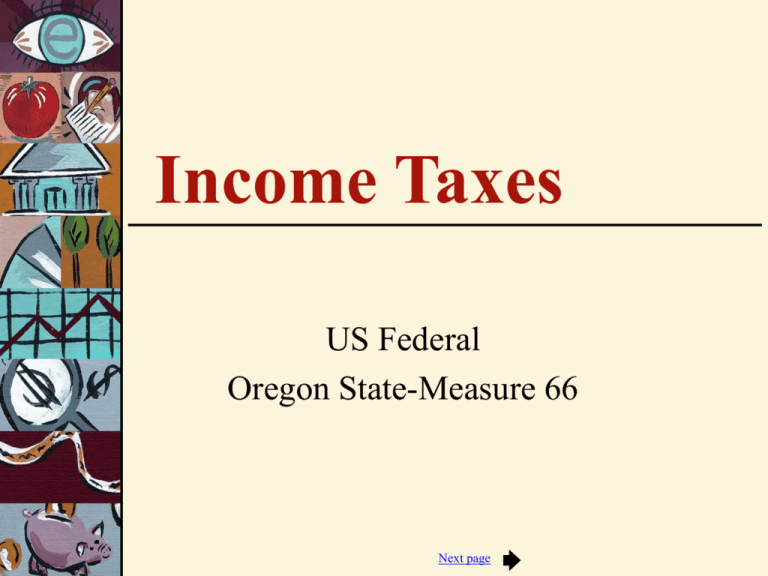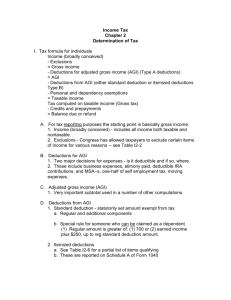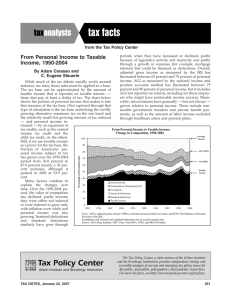Income Taxes
advertisement

Income Taxes US Federal Oregon State-Measure 66 Next page The US personal income tax system was implemented in 1913. In the early years, marginal rates were 1-7%, with most individuals at 4% or less. Today: Basic personal income tax structure Every April 15th, Americans file tax returns that compute liability on their previous year’s income. The first step is the computation of adjusted gross income (AGI). AGI is total income from all taxable sources, less certain allowable costs incurred in earning that income. Sources of taxable income are primarily wages, dividends, interest, business and farm profits, rents, royalties and prizes, and can include the proceeds from embezzlement. Jump to first page Jump to first page Jump to first page Note that exemptions and deductions decrease taxable income, not taxes owed. Tax credits decrease taxes owed, not taxable income. Therefore $1 of exemption or deduction is worth less than $1 of tax credit. Definition of Income The legal standard: The constitutional amendment allowing an income tax in 1913 states “The Congress shall have power to lay and collect taxes on incomes, from whatever source derived.” “from whatever source derived” does not specify a particularly clear standard for taxable and excluded income. Haig-Simons (H-S) criterion: Income is the money value of the net increase in an individual’s power to consume during a period, whether or not the consumption takes place. Jump to first page Additionally, the H-S criterion requires that any decrease in an individual’s potential to consume be subtracted in determining income. For example, if Sylvia freelances as a web designer and earns $35,000 in 2007, but the cost of hardware, software and office materials to maintain her business in 2007 are $5000, then the H-S criterion says her actual 2007 income is $30,000. Jump to first page Excludable forms of income Interest on state and local bonds Interest earned by taxpayers on bonds issued by state and local governments is tax exempt. There is no reason for this to be true under the H-S income definition. If t is an investor’s marginal tax rate and r is the rate of return on taxable investments, she is willing to purchase nontaxable bonds with rates of return >= (1-t)r. This lets state and local governments borrow money at lower rates. Capital gains Increases in the value of an asset are called capital gains, decreases in its value are capital losses. For example, if Jason owns $10,000 in General Electric stock and the stock price goes up until Jason’s stocks are worth $12,500, then Jason has had a $2500 capital gain. If Jason then sells the stock, we call the gain realized. If he does not sell the stock it is unrealized. Jump to first page Capital gains are taxed at preferential rates. While 2007 marginal tax rates on other income, like wages, go as high as 35%, the max marginal rate on capital gains is 15%, as long as the asset was held at least 1 year. This preferential treatment is not particularly in line with the H-S criterion. Capital losses can offset capital gains. This offset is consistent with the H-S criterion. Other ways the tax treatment of capital gains departs from the H-S criterion: • Only realized gains are taxed. Taxes are not paid on the appreciation of an asset until the asset is sold. This may seem like a minor issue, but actually it’s a biggie in terms of the taxes it allows long-term investors to avoid. If Anne purchases an asset for $100,000 and it increases in value at 12% a year, -- after 1 year it’s worth $100,000 (1 .12) $112,000. -- after 2 years it’s worth $112,000(1.12) $100,000(1.12)2 $125,440. Anne’s pre-tax capital gain is $25,440 if she sells after 2 years. If the capital gains tax rate is 20%, she pays $25,440 x .20 = $5088 in taxes and has an aftertax gain of $20,352. Jump to first page If Anne purchased the same $100,000 asset with the same 12% rate of return, but the gains were taxable as they occurred whether or not they were realized, -- after 1 year and the 1st year’s tax it’s worth $100,000 (1 .12) ($12,000.20) $112,000 $2400 $109,600. -- after 2 years and the 1st & 2nd years’ taxes, it’s worth $100,000(1.096)2 $120,122. Anne in this case realizes only a $20,122. The difference here seems small, but compounded annually over many years the difference in after-tax returns to investors can be very large. Over 20 years at 12% with an initial investment of $100,000 the difference is more than $150,000. For the above reasons, a tax accountant’s mantra is ‘taxes deferred are taxes saved’. Jump to first page Gains not realized at death: If Jonathan has an asset worth $1000 an it appreciates to $1200 and then he dies, the $200 capital gain is not subject to income tax. Further, when his heir Cassondra sells the asset, her taxes are calculated as if she initially bought it for $1200. “basis step-up” THEREFORE the US tax treatment of capital gains is not consistent with the H-S criterion. Note that in Germany and the Netherlands capital gains from securities are generally tax exempt. Rationalizations for preferential treatment of capital income? •Preferential treatment is needed to stimulate saving and risk taking by investors, which contributes to economic growth. (it is empirically unclear whether the preferential capital gains tax increases saving or risk taking.) •The US tax system does not allow for the adjustment of asset values from nominal to real $s, causing inflation to lead to the over-taxing of capital assets. Preferential rates serve to offset the implicit taxation of capital through the failure of the tax system to index assets for inflation. (more on this later) •Corporate income tax & “double taxation” Jump to first page Employers’ contributions to employees’ retirement funds, the interest on those funds and employer contributions to employees’ medical insurance plans are untaxed. • Some types of saving are tax-favored. They include -- Individual Retirement Account (IRA), in which a worker without a pension at work can deposit up to $4000/yr. Single (married) workers with pensions and with AGIs less than $50,000 ($70,000) can also participate. Contributions are taken out of the AGI, and so are completely tax deductible. Interest in the accounts accrues untaxed, and account funds are only taxed when they are withdrawn at retirement. -- A Roth IRA is like an IRA, with a $4000 permitted contribution. However, the contribution is not tax deductible. Singles (married couples) with annual incomes les than $95,000 (150,000) are fully eligible for the Roth IRA, and contributions grow untaxed. -- An employee (of a participating employer) can contribute up to $15,000 of pre-tax income to a 401(k) plan. -- Keogh plans allow self-employed individuals to exclude 20% of net business income up to $44,000/yr from taxation. Keogh accounts are also allowed to grow untaxed. Jump to first page Tax preferred savings accounts are intended to stimulate saving. However, economists do not agree that these programs have in fact increased aggregate saving. Gift and inheritance taxes are not subject to federal income taxes. Instead, they are subject to a separate set of taxes specifically for gifts and inheritances. Exemptions and Deductions Exemptions Families are allowed an exemption for each member. The exemption was $3650 in 2010, remains the same this year. Exemptions are phased out for high income families. Why are there exemptions? (1) Exemptions adjust our measure of ability to pay for the presence of children. (2) Exemptions make the US tax system more progressive. Deductions The other subtraction from AGI is the family’s deduction. Two sorts of deductions are allowed: the itemized deduction and the standard deduction. Taxpayers may take one or the other, not both. Jump to first page Some allowable itemized deductions are: • Unreimbursed medical expenses > 7.5% AGI. • State and local income and property taxes. The argument is that these are nondiscretionary decreases in ability to consume. These can only be taken by itemizers. In some sense, this represents another subsidization of state & local governments in the tax code. (Elect sales tax rather than income tax) • Interest expenses. Certain interest payments are deductible. Most relevant for you are deductions for student loan interest. Student loan interest up to a cap is deductible even for non-itemizers. There’s an income ceiling on this ($75,000) above which the deductibility of interest payments is phased out. Additionally, mortgage interest for the purchase of up to 2 homes, worth up to $1 million, interest on home equity loans up to $100,000 & interest on some loans to support the purchase of financial assets are deductible, with some limitations. • Charitable contributions. Individuals can deduct charitable contributions made to religious, charitable, educational, scientific or literary institutions of up to 50% of AGI. Jump to first page • Do all of these deducations meet the H-S criterion? Business expenses? Home loan interest? Charitable giving? Deductions and complexity Each allowable itemized deduction presents a cost to the IRS and to taxpayers, as it increases the complexity of the tax code. Itemized deduction and phaseout Itemized deductions are reduced by 2% of the amount by which AGI exceeds $150,500, up to a max of 80% of deductions. Clearly this makes itemized deductions less regressive. Jump to first page Other itemized deduction issues: (1) Deductibility and relative prices. If expenditures on commodity Z are deductible, then the after-tax price of Z is (1-t) * Z’s market price, where t is the taxpayer’s marginal rate. Suppose Z costs $10, but Luke’s marginal tax rate is 31%. Then Luke’s after-tax price of Z is $6.90. In general, allowing Z to P be deductible Z lowers its effective price for itemizers, but not others. . PZ (1t ) P exploit facets of the tax code to (2) Tax arbitrage. When taxpayers Z increase their incomes, this is tax arbitrage. One example comes from the combination of the deductibility of interest combined with the exemption of certain types of capital income from taxation. Jump to first page Standard deduction The standard deduction was introduced in 1944 to simplify the tax system. It’s a fixed deduction available to all taxpayers, and was $10,700. for couples and $5350 for singles for 2010. It’s indexed to inflation, and taxpayers may either itemize or take the standard deduction. **About 67% of returns take the standard deduction.** Tax expenditures: Failure to include some item in the tax base results in a loss of revenue to the US Treasury. For example, TANF is a government expenditure program in which government pays cash to needy families. The EITC is a tax program in which some portion of the work income of lowearning families is excluded from taxation. The EITC, therefore, is a tax expenditure. The Congressional Budget Office is required to compile a tax expenditure budget annually, to make clear to legislators and voters how much the government expends on its citizens in the form of tax breaks. Jump to first page Alternative Minimum Tax In 1969, 155 U.S. individuals with > $200,000 income used loopholes to pay no tax. The alternative minimum tax (AMT) was the policy response, intented to make sure that households with rather high incomes who take advantage of various tax preferences pay more than 0 taxes. Under the AMT, an income calculation based on the AGI and other factors is made. Exemptions of $42,500 ($62,500) for singles (couples) are allowed, but are fazed out at high incomes. The remaining income is subject to 26% tax on the first $175,000 and 28% on the rest. The AMT is NOT indexed for inflation. What would we expect to happen as a result? Comments on the AMT concern today-- Jump to first page Taxes and inflation The personal exemption, the standard deduction, the bounds of each income bracket, the EITC and thresholds for deduction and exemption phase-outs are adjusted annually to offset the effects of inflation on the real values of these amounts. This is called tax indexing. What would happen without indexation? For starters, we’d have the problem of bracket creep. If taxpayers’ incomes increased at the same rate as the overall price level, then their real incomes, or purchasing power increases with a given year’s earnings, would not have changed. Their nominal incomes, the number of $’s earned, would go up. If our tax system fixed income brackets in nominal terms, with no provision for them to respond to inflation, then bracket creep, in which the same income in real terms climbs into higher and higher tax brackets over time, would result. Two tax areas in which lack of indexation is a problem: i. Capital gains. As noted earlier, capital gains are not indexed. Consider this example of the problem: Suppose Jared buys an asset worth $5000 this year. He sells it in 2010, for $10,000. Suppose also that inflation over the next 3 years is such that the price level doubles. Jared’s nominal selling price must then be $10,000/2 = $5000 in 2007 $’s. Unfortunately, the capital gains tax does not adjust the nominal sale price to the real sale price, and therefore Jared pays taxes on his $5000 nominal gain. Jump to first page ii. Taxable interest income earners also suffer from a lack of indexation. If the nominal interest rate, the rate observed in the market, is 16%, but inflation is 12%, then the real interest rate is only 4%. If Jennifer receives taxable interest income that’s nominally 16% of the asset amount, but really 4%, then she is taxed on the entirety of the 16% interest income. Jump to first page The 2010 Showdown The Economic Growth and Tax Relief Reconciliation Act of 2001 (EGTRRA) introduced large changes in, among other things, • Marginal income tax rates – lowered, top bracket now 35 down from 39.6, introduced the 10% bracket, lowered others gradually • Capital gains taxes –down to 5 & 15% brackets, were as high as 28% •On January 1, 2011 tax system was supposed to revert to its year 2000 status, barring legislative intervention. Jump to first page Oregon Jump to first page





